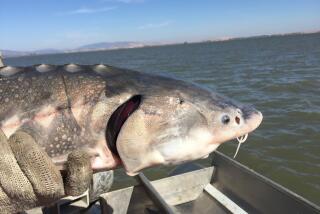From Biogenics Lab to Home Aquariums, It’s the GloFish
- Share via
Biotech entrepreneurs on Friday unveiled plans to market the nation’s first genetically engineered pet -- a tropical zebra fish infused with the gene of a sea anemone that makes it glow fluorescent red -- touching off a debate over who should control the release of transgenic animals.
The freshwater fish with mixed and matched genes cannot be imported or sold in California unless state officials relax rules designed to make sure genetically altered fish don’t pose a threat to the environment.
And a consortium of conservation and food-safety groups has asked federal regulators to intervene and halt the marketing of genetically altered pet fish nationwide.
Promoters of the trademarked GloFish said that zebra fish, with or without the fluorescent gene, are perfectly safe and have been test subjects for decades in biological research labs throughout the United States.
They point out that despite innumerable escapes from breeding pens and labs over the years, zebra fish, accustomed to the balmy waters of their native India and Bangladesh, have never established a wild colony in the nontropical waters of the United States. And if they glow fluorescent red, escapees would be easier targets for predators and thus even less likely to survive.
“A lot of the concern is: ‘What if this fish gets out and interbreeds with wild populations?’ ” said Alan Blake, chief executive officer of Yorktown Technologies in Austin, Texas. “But there are no wild populations in the United States, despite being sold by the millions over the years.”
Blake said his company, working with a pair of ornamental fish farms in Florida, holds exclusive U.S. rights to the patented technology developed at the National University of Singapore. They plan to release the pet fish on the market Jan. 5.
The aquarium industry anticipates a big splash, with a boost in Christmas sales of fish tanks in anticipation of the novelty. This is the first genetically altered pet being produced for market, but researchers are working on others, including an allergen-free cat.
Zebra fish, which are 1 1/2 inches long and normally light gray with black stripes, are widely used in biomedical laboratories for research in genetics, molecular biology and vertebrate development. Geneticists began splicing the fluorescent genes of jellyfish into zebra fish eggs as genetic markers or to “light up” in the presence of toxins.
Initially, researchers used the green fluorescent protein isolated from a jellyfish to produce green fish, and then altered the proteins to create yellow fish. More recently, they cloned the red fluorescent protein from a sea anemone to create red fish.
Yorktown Technologies, along with Segrest Farms and 5-D Tropical, announced Friday their first release will be a red zebra fish. Other colors will follow. These genetically enhanced fish do not generate their own light, but simply reflect it. Under daylight, they radiate red. Under ultraviolet or black lights, they seem to glow red in the dark.
The fish farms are cultivating the fluorescent fish by the thousands, Blake said, and the partners are expecting demand for them -- priced at about $5 apiece -- to climb into the millions.
The U.S. Food and Drug Administration’s Center for Veterinary Medicine asserts jurisdiction over the commercial development of genetically altered animals, such as cows designed to produce more milk.
In talking to FDA officials, Blake said, they “did not say they had any regulations for ornamental fluorescent fish. We also checked with the U.S. [Environmental Protection Agency, the Department of Agriculture] and U.S. Fish and Wildlife Service. None of them has any regulatory concerns with an ornamental fluorescent zebra fish.”
Yet a collection of food-safety and conservation groups sent a letter this week to the FDA , urging immediate intervention.
“If FDA somehow fails to regulate the proposal of Yorktown Technologies ... it will set a precedent for all other [genetically engineered] fish producers and the floodgates will almost literally be opened,” wrote Andrew Kimbrell, executive director of the Center for Food Safety. Other groups signing the letter included the Sierra Club, Greenpeace and the National Environmental Trust.
An FDA spokeswoman on Friday did not have immediate comment.
Fluorescent fish are now sold in Taiwan, Malaysia and Hong Kong, but were rejected by the aquarium industry in England over concerns about genetically modified organisms.
In the U.S., the National Academies of Science raised concerns over the potential of ecological havoc should a highly mobile, fast-breeding transgenic species escape into the wild.
California has banned the cultivation of transgenic fish in the ocean, but allows them to be raised in secure research labs.
But Ed Pert, a California Department of Fish and Game official, said he doesn’t see how a transgenic fish aimed at the home aquarium market could meet environmental safeguards. “People get tired of their pets,” Pert said, “and when they want to get rid of them, they often don’t want to kill them, so they let them go in a local stream or lake.”
Promoters of GloFish have urged California to exempt the fluorescent zebra fish and supplied letters from prominent scientists attesting to low risk.
Pert said he expects the department’s recommendation next week. The matter is to be debated before the Fish and Game Commission on Dec. 4.
More to Read
Sign up for Essential California
The most important California stories and recommendations in your inbox every morning.
You may occasionally receive promotional content from the Los Angeles Times.










